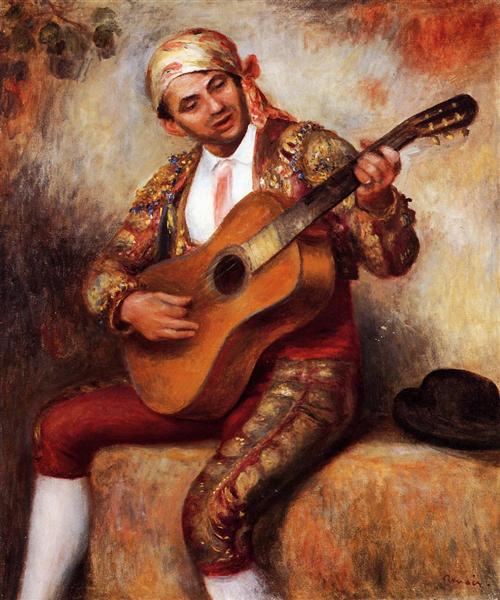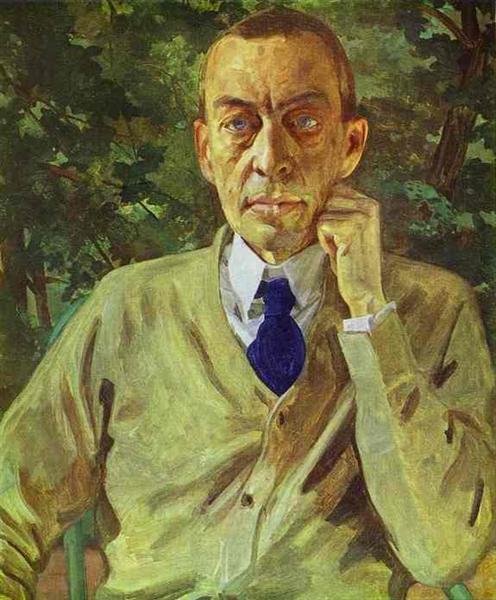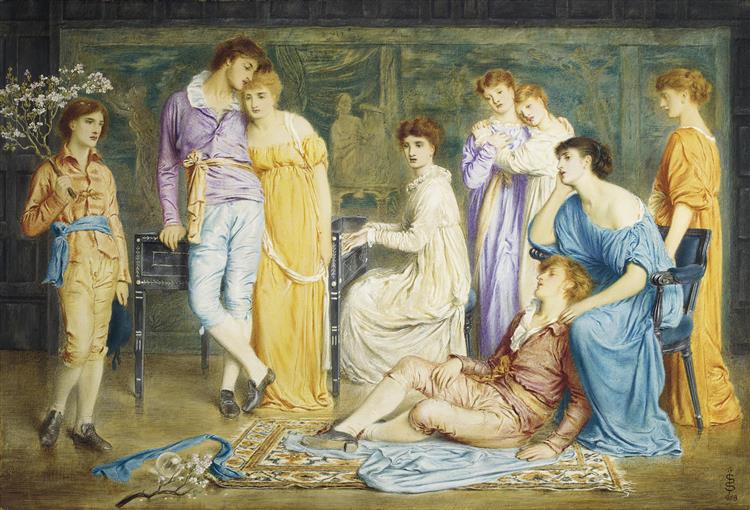Richibi’s Weblog
Just another WordPress.com weblog
Category: how to listen to music if you don’t know your Beethoven from your Bach
August 15, 2023
if you’ve listened to the pieces I’ve
July 22, 2023
how to listen to music if you don’t know your Beethoven from your Bach, XVII – on preludes
“A Prelude by Bach“ (1868)
Simeon Solomon
__________
what’s a prelude
as the word suggests – pre, from the
Latin, means before, lūdus, again
from the Latin, means game, play,
spectacle – it is a piece of music that
precedes another more elaborate
segment in a compositional whole
a prelude is therefore likely to be short,
otherwise completely improvisatory,
no technical demands, just something
that comes from the heart
there probably existed preludes before
Bach, but he’s the one who put them
on the map, with, specifically, his
monumental Preludes and Fugues,
though that’s another story, more
about which later, but he did write
some stand-alone preludes, for
instance his Six Little Preludes,
BWV 933-938, from around 1717
to 1720, see above
a little over a hundred years later,
in 1834, Chopin picked up the
mantle and wrote his own iconic
Opus 28, 24 stand-alone preludes,
one for every major and minor key,
and established thereby the prelude
as a viable musical form
nearly a hundred years later still,
Debussy set up his own homage
to Chopin, in two bursts of inspired
composition, the twelve preludes of
his Book 1 in 1909 to 1910, followed
by his Book 2, again of twelve preludes,
written in 1912 to 1913
these works are now generally played
in complete sets, though they often
pop up individually as short and sweet
encores here and there at the end of
successful recitals
enjoy
R ! chard
June 13, 2023
how to listen to music if you don’t know your Beethoven from your Bach, XVI – on Chopin
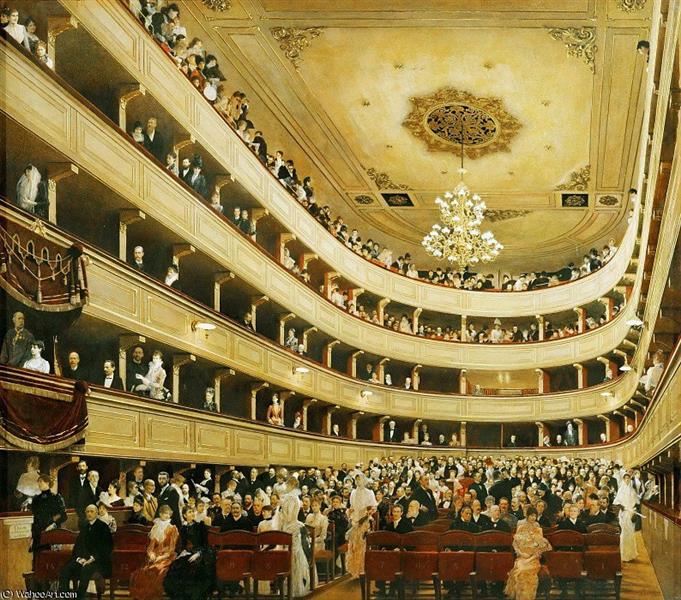
“The Old Burgtheater“ (1888 – 1889)
Gustav Klimt
_______
having brought up nocturnes and ballades
in my last instalment, however peripherally,
I’ll dig into these deeper, to illustrate the
impact Romanticism had on music, on
fine arts as well, and literature, in the
West, as it highlighted emotions as a
requirement of the audiences that
funded them
the French Revolution had happened,
the idea of individual rights, liberty,
equality, fraternity, spread across
even autocracies, czars, kaisers,
kings were threatened
theatres were becoming, because of
the growth of the Middle Class, what
had been the salons of the aristocrats,
people were paying for what the nobility
had been seeing, in concert halls, see
above
but the audience wanted their money’s
worth, both in spectacle, and personal
contact, easy ingenuity was out, they
had to be impacted, get them howling,
whooping, just like today
but to return to ballades and nocturnes,
they were the answer, plangent appeals
to the heart, which had not been a
concern of the earlier Classical Period,
where prestidigitation, technical
wizardry, had been the requirement
of the courtly courts
ballades, nocturnes, preludes, didn’t
exist before the Romantic Period,
essentially, music that hadn’t a
formal structure, hadn’t a set of
compositional rules, but spoke,
rather, from a place of intimacy,
unconstrainedly
here’s a ballade, for instance, here’s
a nocturne, both of Chopin, as
identifiable as Shakespeare, van
Gogh, in each their own particular
vocabulary, wearing his heart on
his sleeve, and always absolutely
extraordinary
enjoy
R ! chard
June 1, 2023
how to listen to music if you don’t know your Beethoven from your Bach, XV – what’s a rhapsody
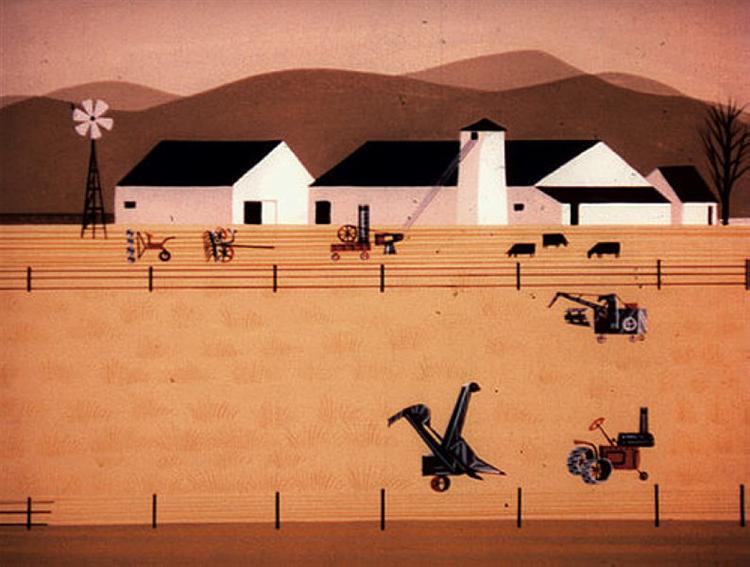
“Rhapsody of Steel“ (1959)
________
so what’s a rhapsody
if you’ve been following at all my
musical adventure, you’ll have
heard by now several rhapsodies
at first, I suggested that the rhapsody
was an evolution from the fantasia,
a piece of music in one movement
that allowed for any internal
construction, but that, after the
Classical Period, became imbued
with Romanticism, passion became
a condition of music, mere technical
ability was no longer enough
note that the audience was different,
rather than nobles who commissioned
artists to decorate their salons, the
burgeoning Middle Class was hungry
for them to entertain, performers were
becoming the main attraction, not just
the background, see, for instance,
Beethoven
but not only did rhapsodies spread
from just one player to an entire
orchestra – see Brahms, then
see Gershwin – but its essential
structure, one movement, was
challenged, see Ravel here, or
Rachmaninov, whose rhapsodies
are both composed of distinct
movements, Rachmaninov even
further refining his movements
into variations, for years, I
referred to his Rhapsody on a
Theme of Paganini as his
Variations
all this to say that a rhapsody is
turning out to be not identified
by its structure, its technical
parts, but rather by its intention,
a rhapsody is in the eye of its
composer, like a nocturne, or
a ballade
I’d thought that rhapsodies had
been relegated to the Romantic
Era, with the occasional later
tribute
who, I wondered, could be
writing rhapsodies anymore
but here’s something, however
unexpectedly, you’ll be familiar
with, from 1975, Queen’s Bohemian
Rhapsody, in several movements
– intro, ballad, opera, hard rock,
outro – and including in all of them,
note, voice
all of which speaks of tradition
being a lot closer than one would
think, ancestral, residual, but
defining, traces, like genes,
however updated, however
posthumously interpreted,
pervade, infiltrate, pursue,
inexorably
rhapsodies are in our DNA, it
would appear, for better or for
worse, ever
here’s to them
R ! chard
May 25, 2023
how to listen to music if you don’t know your Beethoven from your Bach, XIV – more rhapsodies
“Rhapsody” (1958)
Hans Hofmann
_______
now that you’ve heard New York in
Gerschwin’s Rhapsody in Blue, and
Vienna in Rachmaninov’s Rhapsody
on a Theme of Paganini, listen to
Hungary, or rather its Gypsy
component, however rejected,
reviled, at the time, but proud
enough, resilient, to strike back
with its infectious music, how
many times have we heard that
story before
Budapest doesn’t sound at all like
Vienna, though they’re only mere
blocks away, essentially, listen,
Liszt’s Hungarian Rhapsody no 2,
in C# minor, he wrote nineteen,
you’ve probably heard this one,
it’s in our DNA
here are a couple of Spanish
rhapsodies, meanwhile, if we’re to
follow a national agenda, Chabrier,
a name you’ve probably never
heard before, but not so, I assure
you, his music, his España,
Rhapsody for Orchestra, is
written in our blood, listen
Ravel wrote also a Rapsodie
espagnole, more French than
Spanish, to my mind, steeped
in its early Twentieth Century
Impressionism, all textures,
soundscapes, not rhythms
Ravel makes up for it, though, in his
Bolero, perhaps the most Hispanic
piece ever of all, you tell me
both Chabrier and Ravel, incidentally,
were French, doing what Dvořák, a
Czech, had done, would do, for
Americans, honour their fascinating
rhythms
Liszt, by the way, was Hungarian, his
rhapsodies were native, if profoundly
influenced by Vienna
listen, enjoy
R ! chard
May 10, 2023
how to listen to music if you don’t know your Beethoven from your Bach, XIII – Antonin Dvořák
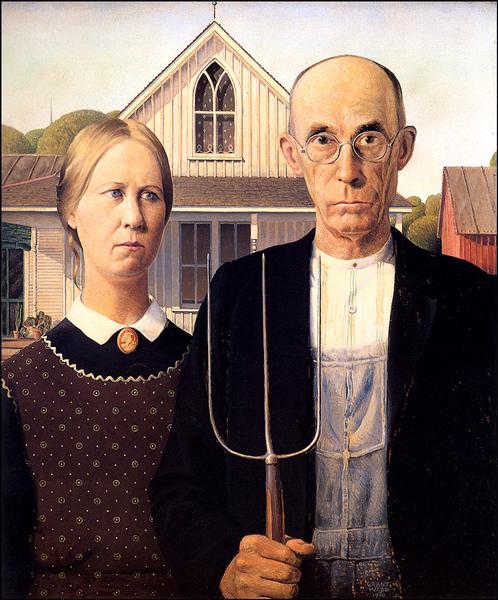
“American Gothic“ (1930)
Grant Wood
______
if you were able to hear the difference
in my last communication between
Vienna and New York in the two
rhapsodies I compared, contemporaries,
incidentally, you might be interested in
a European composer, highly
underestimated in my opinion, who
bridges both cultures by composing a
tribute to the country that receives him,
gloriously, for a couple of years, before
he returns, homesick, to his beloved
Bohemia, which is to say, Prague,
Antonín Dvořák, don’t ask, 1841 – 1904
here’s his 12th String Quartet, nicknamed
the “American”, listen, you’ll understand
why
here’s his New World Symphony, again
you’ll understand why
fun facts, Neil Armstrong brought a
recording of it, the New World
Symphony, with him to the moon
during the first manned landing,
back in 1969, can you get more
cool than that
also, this particular version is from
Pyongyang, which is to say, North
Korea, which is to say, the audience
here is nearly as interesting as the
symphony itself, do they even
speak the language, if they grew
up on Chinese opera
do you
R ! chard
April 26, 2023
how to listen to music if you don’t know your Beethoven from your Bach, XII – on rhapsodies
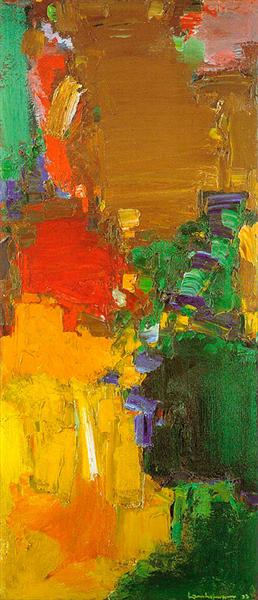
“Rhapsody“ (1958)
_____
if, in my last instalment, I compared iconic
funeral marches, let me do the same for
a couple of iconic rhapsodies, another
musical form that came and went, that’s
come and gone, but not forgotten
what’s a rhapsody
as far as I can make out, it’s much the
same as a fantasia, if you can remember
what a fantasia is, a free form composition,
but with a Romantic, which is to say a
heartfelt, twist, more pathos, less
technical wizardry
Gershwin wrote his Rhapsody in Blue
in 1924, you can hear New York, Times
Square, Broadway, from the first wail
of the languid horn
Rachmaninov’s Rhapsody on a Theme
of Paganini, written in 1934, ten years
later, gives you, however, Vienna, its
Romantic Period, the traditions of,
a century earlier, Beethoven, Schubert
Rachmaninov is personal, introspective,
tragic, Gershwin is extroverted, social,
fun
Rachmaninov looked back to his
European, Old World, traditions,
Gershwin augurs an entirely new
voice
listen, you can hear it
enjoy
R ! chard
March 16, 2023
how to listen to music if you don’t know your Beethoven from your Bach, XI
.jpg!Large.jpg)
“Funeral in the Snow near the Old Tower“ (1883)
_________
having introduced, however peripherally, in my
last instalment, Chopin’s Piano Sonata no 2,
it wouldn’t be fair to not present Beethoven’s
Piano Sonata no 12 to compare, they both
contain iconic funeral marches, written, even
if you have no interest at all in such music, in
the blood of our Western culture, like
Shakespeare, to be or not to be, you’ve
heard the line, somewhere, even if you have
no idea what he might’ve been talking about
I don’t need to point out the dirges among
the movements, the solemn bits, they will
impose themselves, whether you’re paying
attention or not
Beethoven and Chopin sound a lot alike,
Beethoven, 1770 -1827, is earlier, pushed
the Classical Period into the Romantic Era,
pretty well, astonishingly, by himself
Chopin, 1810 – 1849, gives us the pinnacle
of Romantic music
I tell them apart by their beat, Chopin is
always on, Beethoven is always off, his
schtick, his revolutionary spirit, Chopin,
rather, played for the aristocracy, in
their courtly salons, much like Haydn,
but that’s another story
you might notice also that the last
movement in Chopin’s sonata is
all texture, a precursor to the later
Impressionism, in all of the arts
Beethoven, however, always takes
you on a journey, never gives you
merely background, there’s always
a core, a foundational melody
enjoy
R ! chard
March 4, 2023
how to listen to music if you don’t know your Beethoven from your Bach, X
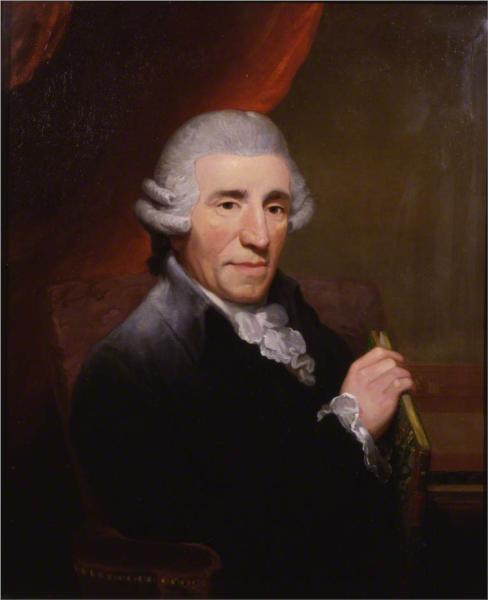
“Joseph Haydn” (1791)
Thomas Hardy
_______
though I’ve focused especially, during
this introduction to Classical music,
on Mozart, a second great pillar of
that era is Haydn, 1732 – 1809
here is one of his 62 piano sonatas,
which expresses more than anything
you’ve heard here yet the definition
of what music was at the time, or
should be, tonality, as I’ve earlier
said, tempo and repetition were
tantamount
listen for or the rigidity of the tempo,
the consistent melliflousness of
the melody, and therefore tonality,
and the repetition of all the
component tunes
I remember going to a drum recital
once, here in Vancouver, a guy was
expressing his artistry in a formal
venue, I was sitting in a forward
row, saw him set up his music on
his music stand, and I thought,
he’s going to have to turn the
pages, which he did, a drummer
that’s all I remember of the
presentation, but that was enough,
an entire revelation
in this Haydn sonata, the pianist
turns the pages of his score, back
and forth, an interesting visual
expression of the imperative of
repetition in that era’s music,
having to return to what had
been written on the previous
page
also note that trills abound
note too in the second movement,
the adagio cantabile, the sudden
introduction of arpeggios,
transcendent, as though angels
had just appeared
which prefigures the metaphysical
aspirations of the Romantic Period
which ensued, see, for instance,
Chopin
note also that we’re on fortepiano
here, a period instrument, a cross
between the harpsichord and the
modern instrument
thoroughly enjoy
R ! chard
March 2, 2023
how to listen to music if you don’t know your Beethoven from your Bach, IX
